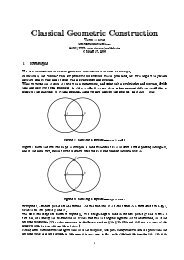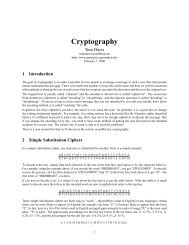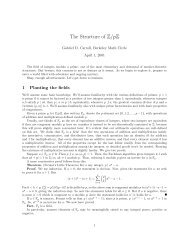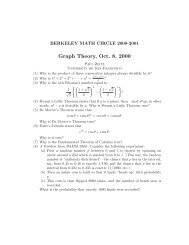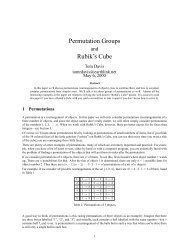INFINITY: CARDINAL NUMBERS 1. Some terminology of set theory ...
INFINITY: CARDINAL NUMBERS 1. Some terminology of set theory ...
INFINITY: CARDINAL NUMBERS 1. Some terminology of set theory ...
You also want an ePaper? Increase the reach of your titles
YUMPU automatically turns print PDFs into web optimized ePapers that Google loves.
<strong>INFINITY</strong>: <strong>CARDINAL</strong> <strong>NUMBERS</strong> 5<br />
8. Arithmetic <strong>of</strong> cardinal numbers<br />
Suppose S = {1, 2} and T = {1, 2, 3}. Relabelling the elements <strong>of</strong> T yields a <strong>set</strong> T ′ =<br />
{a, b, c} <strong>of</strong> the same cardinality, but which is disjoint from T . Then 2 + 3 = #S + #T =<br />
#(S ∪ T ′ ) = #{1, 2, a, b, c} = 5. This observation lets one add cardinal numbers in general:<br />
if S and T are arbitrary <strong>set</strong>s then the sum <strong>of</strong> the cardinal numbers #S and #T is defined<br />
to be the cardinality <strong>of</strong> S ∪ T ′ where T ′ is obtained from T by relabeling elements so that<br />
S ∩ T ′ = ∅. For example, in the disjoint union<br />
all three <strong>set</strong>s are <strong>of</strong> cardinality ℵ0, so<br />
{0, 2, 4, 6, . . . } ∪ {1, 3, 5, 7, . . . } = N,<br />
ℵ0 + ℵ0 = ℵ0.<br />
The Cartesian product S × T <strong>of</strong> two <strong>set</strong>s S and T is the <strong>set</strong> <strong>of</strong> all ordered pairs (s, t) where<br />
s ∈ S and t ∈ T . For example, if S = {1, 2} and T = {a, b, c}, then<br />
S × T = {(1, a), (1, b), (1, c), (2, a), (2, b), (2, c)}<br />
so #(S × T ) = 6 = 2 · 3. If S and T are arbitrary <strong>set</strong>s, then the product <strong>of</strong> the cardinal<br />
numbers #S and #T is defined to be #(S × T ). For instance, the elements <strong>of</strong> N × N can<br />
be described by strings <strong>of</strong> typewriter symbols like (5,7), so the Typewriter Principle shows<br />
that #(N × N) = ℵ0. Therefore<br />
ℵ0 · ℵ0 = ℵ0.<br />
These equalities may look strange, but in fact, such behavior is typical: one can prove that<br />
if ℵ and ℵ ′ are cardinal numbers such that ℵ ≤ ℵ ′ and ℵ ′ is infinite, then ℵ + ℵ ′ = ℵ · ℵ ′ = ℵ ′ .<br />
There is no nice way <strong>of</strong> subtracting or dividing cardinal numbers. But one can exponentiate.<br />
If S and T are arbitrary <strong>set</strong>s, let S T denote the <strong>set</strong> <strong>of</strong> functions from T to S. Note<br />
the reversal <strong>of</strong> order! Then (#S) (#T ) is defined to be the cardinality <strong>of</strong> S T . For example, if<br />
S = N and T = {1, 2, 3}, then a sample element <strong>of</strong> S T might be described by<br />
the function {1,2,3}->N sending 1 to 12, 2 to 753, and 3 to 489.<br />
The Typewriter Principle shows that #(S T ) = ℵ0. Hence (ℵ0) 3 = ℵ0.<br />
9. The power <strong>set</strong><br />
The power <strong>set</strong> P(S) <strong>of</strong> a <strong>set</strong> S is the <strong>set</strong> <strong>of</strong> all its sub<strong>set</strong>s. For instance, if S = {1, 2, 3},<br />
then<br />
P(S) = {∅, {1}, {2}, {3}, {1, 2}, {1, 3}, {2, 3}, {1, 2, 3}},<br />
so #P(S) = 8.<br />
For any <strong>set</strong> S, there is a bijection between P(S) and the <strong>set</strong> {0, 1} S <strong>of</strong> functions χ : S →<br />
{0, 1} that maps the sub<strong>set</strong> T <strong>of</strong> S to its characteristic function<br />
χT (s) :=<br />
Therefore #P(S) = # {0, 1} S = 2 #S .<br />
<br />
1, if s ∈ T<br />
0, if s ∈ T<br />
.



